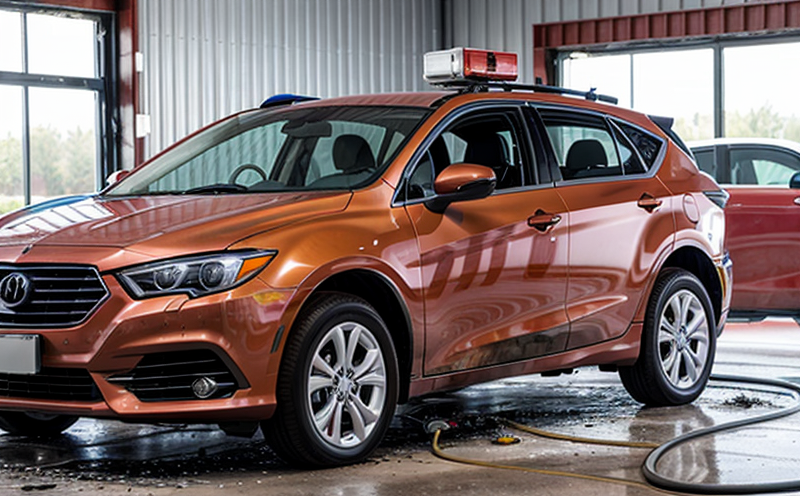Reaction-to-Fire Testing of Safety Belts and Harnesses
In the automotive industry, safety is paramount. One critical aspect of this is ensuring that all components, including safety belts and harnesses, meet stringent fire safety standards. Reaction-to-fire (RTF) testing plays a crucial role in evaluating how these materials react when exposed to heat or flame. This test assesses not only the flammability but also the rate at which flames spread along the material.
The goal of RTF testing is to ensure that the safety belts and harnesses do not ignite easily, burn rapidly, or produce toxic smoke when subjected to fire. This testing helps manufacturers identify potential hazards early in the product development process, ensuring that only safe materials are used in vehicles.
During RTF testing, specimens of the safety belt and harness material are exposed to controlled heat sources under specified conditions. The test measures several key parameters:
- The time it takes for ignition to occur
- The rate at which flames spread along the material
- The amount of smoke produced during combustion
- Any toxic gases released during the test
These tests are critical because they help prevent potential accidents caused by materials that could ignite or cause severe injury in a fire. By conducting this testing, automakers can ensure that their products meet not only regulatory requirements but also exceed expectations for safety and reliability.
The significance of RTF testing extends beyond just preventing fires; it also contributes to the overall design and comfort of the vehicle interior. Materials that pass these tests are often more durable and less prone to damage, enhancing the longevity and value of the product. Additionally, the results from these tests can inform ongoing research and development efforts aimed at improving fire safety in automotive products.
Automotive manufacturers rely on rigorous testing protocols to ensure compliance with international standards such as ISO 12477-2:2018 for seatbelt fabric flammability. These standards provide clear guidelines that help standardize the testing process, ensuring consistency and reliability across different laboratories.
By incorporating RTF testing into their quality assurance programs, automakers can gain valuable insights into the performance of their materials under fire conditions. This information is essential for making informed decisions about material selection, design modifications, and overall product improvement. Ultimately, this testing contributes to a safer driving experience by reducing the risk of injury in case of a fire.
Why Choose This Test
Selecting reaction-to-fire (RTF) testing for safety belts and harnesses is a strategic decision that offers several benefits to automotive manufacturers:
- Regulatory Compliance: Meeting stringent fire safety standards ensures compliance with international regulations such as ISO 12477-2:2018.
- Enhanced Safety: By identifying and addressing potential hazards early in the development process, manufacturers can significantly reduce the risk of accidents caused by flammable materials.
- Improved Product Design: RTF testing provides valuable data that can be used to refine material selection and design, leading to more durable and safer products.
- Increased Market Confidence: Consumers trust brands that prioritize safety. Conducting thorough fire safety tests enhances brand reputation and consumer confidence in the product.
- Competitive Advantage: Leading competitors may already be leveraging RTF testing to gain a competitive edge, and by doing so, manufacturers can stay ahead of the curve.
In conclusion, choosing RTF testing is not just about meeting standards; it's about building trust with consumers, ensuring safety, and creating products that stand out in the market.
Quality and Reliability Assurance
- Consistent Test Results: Our laboratory uses advanced instrumentation to ensure consistent and accurate test results. This consistency is crucial for maintaining high-quality standards in the production of safety belts and harnesses.
- Adherence to Standards: We adhere strictly to international standards such as ISO 12477-2:2018, ensuring that all tests are conducted according to recognized protocols.
- Expertise in Sample Preparation: Our team of experts ensures that samples are prepared correctly before testing, minimizing any potential errors or inconsistencies.
- Data Integrity: We maintain the highest levels of data integrity by using state-of-the-art software and recording systems. This ensures that all test results are accurate and reliable.
We take great pride in our ability to provide consistent, reliable, and accurate testing services. Our commitment to quality is reflected in every aspect of the service we offer, from sample preparation to final reporting.
Competitive Advantage and Market Impact
By incorporating reaction-to-fire (RTF) testing into their product development process, automotive manufacturers can gain a significant competitive advantage. Here’s how:
- Early Identification of Issues: RTF testing allows for the early identification and resolution of potential issues with safety belt and harness materials.
- Enhanced Safety Performance: Products that pass these tests are more likely to meet or exceed safety standards, thereby enhancing their marketability.
- Increased Consumer Confidence: Consumers are increasingly concerned about the safety of products they purchase. By demonstrating a commitment to fire safety through RTF testing, manufacturers can build and maintain consumer trust.
- Differentiation in the Market: Offering products that meet or exceed stringent fire safety standards can differentiate manufacturers from their competitors.
In conclusion, incorporating RTF testing into the product development process is a strategic move that can significantly enhance market performance and competitive positioning. It demonstrates a commitment to quality and safety, which are crucial factors in today’s consumer-driven market.





